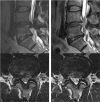Five-year outcomes and predictive factors of transforaminal full-endoscopic lumbar discectomy
- PMID: 30508966
- PMCID: PMC6283221
- DOI: 10.1097/MD.0000000000013454
Five-year outcomes and predictive factors of transforaminal full-endoscopic lumbar discectomy
Abstract
Although several studies have reported the effectiveness of transforaminal full-endoscopic lumbar discectomy (TELD), no cohort study on the long-term outcomes of TELD has been conducted. Thus, this study aimed to evaluate the long-term clinical outcomes of TELD and to determine the factors predicting favorable outcome.Five-year longitudinal data of 204 consecutive patients who underwent TELD were collected. Outcomes were assessed using the visual analog scale (VAS) pain score, Oswestry disability index (ODI), patient satisfaction rating, and the modified Macnab criteria.The mean VAS score for leg pain improved from 7.64 at the baseline to 1.71, 0.81, 0.90, and 0.99 at postoperative 6 weeks, 1 year, 2 years, and 5 years, respectively (P <.001). The mean ODI improved from 67.2% at the baseline to 15.7%, 8.5%, 9.4%, and 10.1% at postoperative 6 weeks, 1 year, 2 years, and 5 years, respectively (P <.001). The overall patient satisfaction rate was 94.1%. Based on the modified Macnab criteria, 83.8% of patients had excellent or good results. In this study, younger patients with intracanal disc herniation tended to have better outcomes than elderly patients with foraminal/far-lateral disc herniation (P <.05).Transforaminal endoscopic lumbar discectomy offers favorable long-term outcomes with minimal tissue damage. Postoperative pain and functional status may change over time. Proper patient selection remains essential for the success of this minimally invasive procedure.
Conflict of interest statement
The authors have no conflicts of interest to disclose.
Figures







Similar articles
-
Radiographic and clinical outcomes of huge lumbar disc herniations treated by transforaminal endoscopic discectomy.Clin Neurol Neurosurg. 2019 Oct;185:105485. doi: 10.1016/j.clineuro.2019.105485. Epub 2019 Aug 9. Clin Neurol Neurosurg. 2019. PMID: 31421587
-
Effects of Ho:YAG Laser Ablation on Postoperative Low Back Pain and Functional Status After Transforaminal Endoscopic Lumbar Discectomy: Minimum of 2-Year Follow-Up.World Neurosurg. 2019 Jul;127:e793-e798. doi: 10.1016/j.wneu.2019.03.265. Epub 2019 Apr 3. World Neurosurg. 2019. PMID: 30951910
-
Transforaminal Endoscopic Lumbar Discectomy Versus Open Lumbar Microdiscectomy: A Comparative Cohort Study with a 5-Year Follow-Up.Pain Physician. 2019 May;22(3):295-304. Pain Physician. 2019. PMID: 31151337
-
Comparative outcomes of obese and non-obese patients with lumbar disc herniation receiving full endoscopic transforaminal discectomy: a systematic review and meta-analysis.BMC Musculoskelet Disord. 2024 Apr 23;25(1):322. doi: 10.1186/s12891-024-07455-5. BMC Musculoskelet Disord. 2024. PMID: 38654321 Free PMC article.
-
Percutaneous endoscopic transforaminal discectomy precedes interlaminar discectomy in the efficacy and safety for lumbar disc herniation.Biosci Rep. 2019 Feb 15;39(2):BSR20181866. doi: 10.1042/BSR20181866. Print 2019 Feb 28. Biosci Rep. 2019. PMID: 30705086 Free PMC article.
Cited by
-
A Differential Clinical Benefit Examination of Full Lumbar Endoscopy vs Interspinous Process Spacers in the Treatment of Spinal Stenosis: An Effect Size Meta-Analysis of Clinical Outcomes.Int J Spine Surg. 2022 Feb;16(1):102-123. doi: 10.14444/8200. Epub 2022 Feb 17. Int J Spine Surg. 2022. PMID: 35177530 Free PMC article.
-
Discectomy for Lumbar Disc Herniation in Pediatric and Adolescent Populations: A Systematic Review and Meta-Analysis.Cureus. 2024 Jul 5;16(7):e63880. doi: 10.7759/cureus.63880. eCollection 2024 Jul. Cureus. 2024. PMID: 39104990 Free PMC article. Review.
-
Insights From ISASS Webinar Series on Current and Emerging Techniques in Endoscopic Spine Surgery | Part 3: A Polytomous Rasch Analysis on Surgeons' Endorsement of Multiportal Access, Treatment of Lumbar Facet Cyst, Grade I Spondylolisthesis, and Interbody Fusion.Int J Spine Surg. 2024 Nov 20;18(S2):S38-S53. doi: 10.14444/8674. Int J Spine Surg. 2024. PMID: 39547674 Free PMC article.
-
Complications associated with lumbar discectomy surgical techniques: a systematic review.J Spine Surg. 2022 Sep;8(3):377-389. doi: 10.21037/jss-21-59. J Spine Surg. 2022. PMID: 36285095 Free PMC article. Review.
-
Percutaneous endoscopic lumbar discectomy for lumbar disc herniation as day surgery - short-term clinical results of 235 consecutive cases.Medicine (Baltimore). 2019 Dec;98(49):e18064. doi: 10.1097/MD.0000000000018064. Medicine (Baltimore). 2019. PMID: 31804313 Free PMC article.
References
-
- Mayer HM, Brock M. Percutaneous endoscopic discectomy: surgical technique and preliminary results compared to microsurgical discectomy. J Neurosurg 1993;78:216–25. - PubMed
-
- Hermantin FU, Peters T, Quartararo L, et al. A Prospective, randomized study comparing the results of open discectomy with those of video-assisted arthroscopic microdiscectomy. J Bone Joint Surg Am 1999;81:958–65. - PubMed
-
- Hoogland T, Schubert M, Miklitz B, et al. Transforaminal posterolateral endoscopic discectomy with or without the combination of a low-dose chymopapain: a prospective randomized study in 280 consecutive cases. Spine (Phila Pa 1976) 2006;31:E890–7. - PubMed
-
- Ruetten S, Komp M, Merk H, et al. Full-endoscopic interlaminar and transforaminal lumbar discectomy versus conventional microsurgical technique: a prospective, randomized, controlled study. Spine (Phila Pa 1976) 2008;33:931–9. - PubMed
-
- Ruetten S, Komp M, Merk H, et al. Recurrent lumbar disc herniation after conventional discectomy: a prospective, randomized study comparing full-endoscopic interlaminar and transforaminal versus microsurgical revision. J Spinal Disord Tech 2009;22:122–9. - PubMed
Publication types
MeSH terms
LinkOut - more resources
Full Text Sources
Medical

